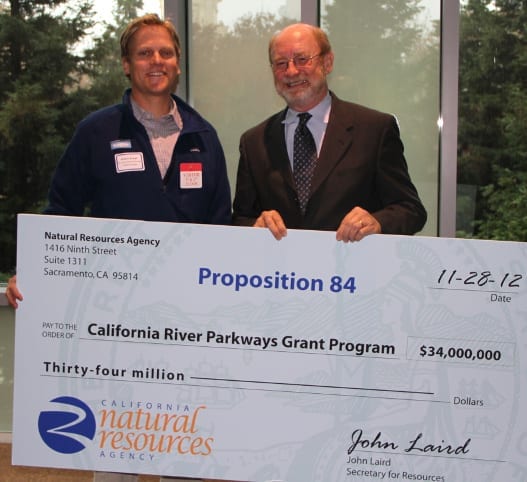CalTrout Awarded $650,000 Grant To Restore California’s Iconic Hat Creek Fishery
Hat Creek restoration funded, work set to begin in 2013
California’s once-productive Hat Creek fishery has suffered the last two decades, and while we outlined the issues and our hopes for restoration in this prior article (and this video), we’re happy to announce those hopes are on the verge of becoming reality.
CalTrout was recently awarded a $650,000 grant by the California Natural Resources Agency to restore fish habitat and create new recreational opportunities on Hat Creek.

Drew Braugh, Conservation Manager of CalTrout’s Mt. Shasta office accepts a check from John Laird.
While some of the funds will be used to improve access, the grant is aimed at improving Hat Creek’s habitat and restoring its once-sizable native fish populations.
“The slow deterioration of conditions in Hat Creek brought on by a combination of unrelated issues, including cattle grazing and burrowing by non-native muskrats, have created crisis conditions for trout,” said Drew Braugh, Conservation Manager of California Trout’s Mt. Shasta Regional Office. “The funds secured today will go a long way toward creating habitat in which these native fish can thrive.”
Recent studies suggest Hat Creek still has the ability to produce big trout, but the lack of cover and habitat makes those populations vulnerable.
CalTrout outlined a preliminary recovery plan in an earlier article, and while we’re finalizing the restoration plans, depositing large woody debris in Hat Creek — to slow flows, provide cover for bugs and fish, and promote the growth of aquatic vegetation — is still central to the recovery of Hat Creek’s native rainbow trout, which used to be supported by massive aquatic weedbeds and invertebrate populations.
In addition to financial support from the Natural Resources Agency, California Trout has worked closely with PG&E, which owns the land, the California Department of Fish and Game, and the UC Davis Center for Watershed Sciences to develop and implement a feasible and scientifically sound restoration plan for Hat Creek.
“Hat Creek is truly at the heart of our mission to protect and restore wild trout and their waters,” said California Trout Executive Director Jeff Thompson. “We have brought wild trout populations back from dire straits in this creek before, and we can do it again.”
We’re excited. This grant represents the fruition of a lot of hard work on the part of CalTrout staff. And we’re sure that — for Hat Creek and California’s fishermen — the best is yet to come.
We’ll provide you with more information about Hat Creek’s restoration as it becomes available.




